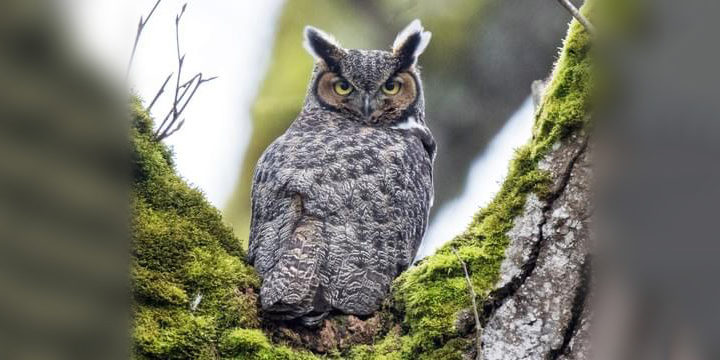Bird of The Week: Great Horned Owl
SCIENTIFIC NAME: Bubo virginianus
POPULATION: 3.9 million in the United States and Canada; global population unknown
TREND: Decreasing
HABITAT: Found in a wide variety of habitats, from tropical and boreal forests to desert
Early naturalists called the Great Horned Owl the “winged tiger” or “tiger of the air” because of its ferocity and hunting skills. This big owl (the second heaviest in North America after the Snowy Owl) is also called the “hoot owl” after its deep, booming call, which sounds like: “Who’s a-wake? Me too!”
In Native American folklore and Greek myth, owls represent wisdom and helpfulness, and have powers of prophecy. The “wise old owl” is also a popular motif in children’s books and cartoons. But the owl is also seen as a familiar of witches, whose silent flight and spooky calls foretell evil and even imminent death.
A Devilish Darker Side?
Although this owl may occasionally spook people, it’s not a horned devil. The “horns” atop a Great Horned Owl’s head are actually tufts of feathers called plumicorns, meaning “feather horns” in Latin. Although they are sometimes called “ears,” plumicorns have nothing to do with the bird’s hearing, and scientists are not sure of their exact function. It’s speculated that the tufts may help camouflage the Great Horned Owl within its favored forest haunts.
Adaptable Owl
Like the Barn Owl and Short-eared Owl, the Great Horned Owl has a wide distribution, found from the northern boreal forests of Alaska and Canada south through the mountains and deserts of Patagonia — an impressively large portion of the Americas. This species varies in plumage color and pattern across its broad range, with 15 recognized subspecies. All Great Horned Owls are cryptically colored and blend with their surroundings while roosting.
Great Horned Owls are non-migratory and territorial, preferring to remain within a home range of several hundred acres. They favor dense forest near open areas, habitat often shared by their daytime counterparts, Red-tailed Hawks.
Eating Crow
The Great Horned Owl is a fearsome nocturnal predator, drifting silently through the night on five-foot-wide wings. This powerful hunter captures a wide range of creatures. These include large insects, amphibians, reptiles, and birds, including, on occasion, Peregrine Falcons, other owls, geese, and herons. Mammals are favored quarry, particularly rodents and rabbits. Their dietary flexibility allows Great Horned Owls to live in a wide variety of habitats, including cities.
Crows and Blue Jays seem to have a particular dislike of Great Horned Owls, which often raid their roosts by night. During the day, a resting owl can often be located by watching for a noisy and agitated mob of crows, which harasses the sleepy predator until it silently flaps on to a more sheltered spot.
Winter Courtship
Like Bald Eagles, Great Horned Owls begin to nest in late winter, usually December through February. They don’t build their own nests, instead reusing the nest of another large bird such as a hawk. They may also nest on cliff ledges, in caves, or on broken-off snags. Great Horned Owl pairs hoot back and forth to each other while courting. The smaller male can be told by his lower call. Pairs are monogamous and tend to remain on the same territory year after year.
Protecting the Winged Tiger
Although Great Horned Owls are still considered common in many areas, Partners in Flight data show a 27-percent decline in their U.S. and Canadian population in recent years. Like most birds, these big owls are vulnerable to habitat loss. Rat and mouse poisons harm Great Horned Owls through their rodent prey, and many owls are injured and killed by collisions with cars and fencing.
SOURCE: AMERICAN BIRD CONSERVANCY abc.org


